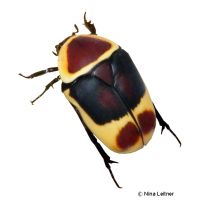Congo Flower Beetle (Pachnoda marginata)
| Congo Flower Beetle Pachnoda marginata | |
|---|---|
| Name | Congo Flower Beetle |
| Name Lat. | Pachnoda marginata |
| Family | Fruit and Flower Chafers |
| Family lat. | Cetoniidae |
| Order | Beetles |
| Order lat. | Coleoptera |
| Origin | Central Africa |
| Habitat | Forest, savanna |
| Diet | Fruits, beetle jelly, maple syrup |
| Humidity | 60-80 % |
| Behavior | Diurnal |
| Keeping | Pair, group |
| Care Level | Easy |
| Housing | Semi-humid terrarium |
| Breeding | Simple |
| Life Span | 5-7 months |
| Protection | No |
| Metric Units | |
| Size | 20-25 mm |
| Temperature Day | 25-27 °C |
| Temperature Night | 18-20 °C |
| Housing Size | 40 x 30 x 30 cm |
| US Units | |
| Size | 0.8"-1" |
| Temperature Day | 77-81 °F |
| Temperature Night | 64-68 °F |
| Housing Size | 15" x 10" x 10" |
Distribution and habitat
The Congo rose beetle is widespread in West and Central Africa from Senegal through Cameroon and Congo to Kenya. There they inhabit different habitats, such as rainforest, bush and shrub savannas.
Maintenance
A terrarium of e.g. 40 x 30 x 30 cm (L x W x H) is recommended. A hinged lid terrarium or an aquarium with a tightly closing lid made of the finest gauze is best suited. The terrarium should be placed in a quiet place without direct sunlight
The substrate, at least 15 cm deep, should be a slightly moist deciduous forest or terrarium humus mixed with a little white rotted wood, with the bottom layer (about 5 cm) well compacted. On top of this some foliage for cover (shelter and hiding places) and/or e.g. Flake Soil, some branches for climbing and uprighting and pieces of bark or moss cushions to maintain humidity.
Several times a week the inside of the terrarium should be finely sprayed (humidity), waterlogging and mold should be avoided at all costs
| Temp. day: 25-27 °C | Temp. night: 18-20 °C | Humidity: 60-80 |
The lighting duration should be 8-10 hrs. Daylight fluorescent tubes supplemented with spotlights that generate the necessary heat are ideal.
Diet
The food for adult beetles (imagines) consists of ripe fruit, especially suitable are bananas, apples, pears and mangoes, maple syrup, Beetle Jelly and flower pollen. Fruit and maple syrup meet their fluid needs. Citrus fruits are not suitable
Larvae feed on deciduous forest humus and white rotted wood, shredded as finely as possible for better absorption, or finished products made from fermented wood substrate (e.g. Flake Soil). Moderate feeding (max. half teaspoon per week) of ground silkworm pupae promotes growth.
Recommended feeding is two to three times a week, too little feeding leads to cannibalism among the larvae. A regular and varied diet promotes health and prevents deficiency symptoms.
Reproduction and breeding
The male beetles can be recognized by the furrow on the underside of the abdomen
After mating, the female lays up to 180 eggs in the soil substrate. The generation period is 5-8 months depending on the temperature
At temperatures below 18 °C reproduction does not take place.
Important
There are numerous subspecies and breeding forms, which deviate from the species-typical black-yellow coloration and pattern
They are able to fly well and, like all rose chafer beetles, have the cover wings closed.
It is important to have a certain amount of moisture in the food, because the animals only take the necessary liquid through their food.
A sufficiently deep bottom substrate is essential, as the substrate is both food and habitat for the larvae. The temperature in the moist bottom substrate should be 22-24 °C. A regular substrate exchange is necessary, whereby the intervals can be several months depending on the stocking.
The terrarium must have good ventilation without drafts and meet the species-specific needs. Measuring devices such as thermometers, hygrometers, etc. are necessary. The lighting has to correspond to the species-specific day-night rhythm and has to be placed in such a way that the animals cannot injure themselves. The terrarium should be locked in such a way that neither unauthorized persons can open it nor the animals can escape. Contamination must be removed regularly
Further literature can be found in your pet store.
References
Text: Nina Rassinger; Image: Nina Leitner
Source: HENKEL & SCHMIDT (2010): Taschenatlas Wirbellose für das Terrarium, Ulmer Verlag; ENGELMAN & LANGE (2011): Zootierhaltung - Tiere in menschlicher Obhut: Wirbellose, Verlag Harri Deutsch
